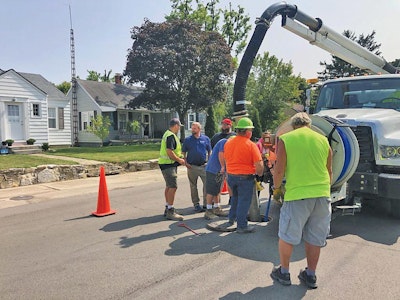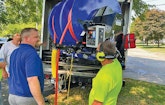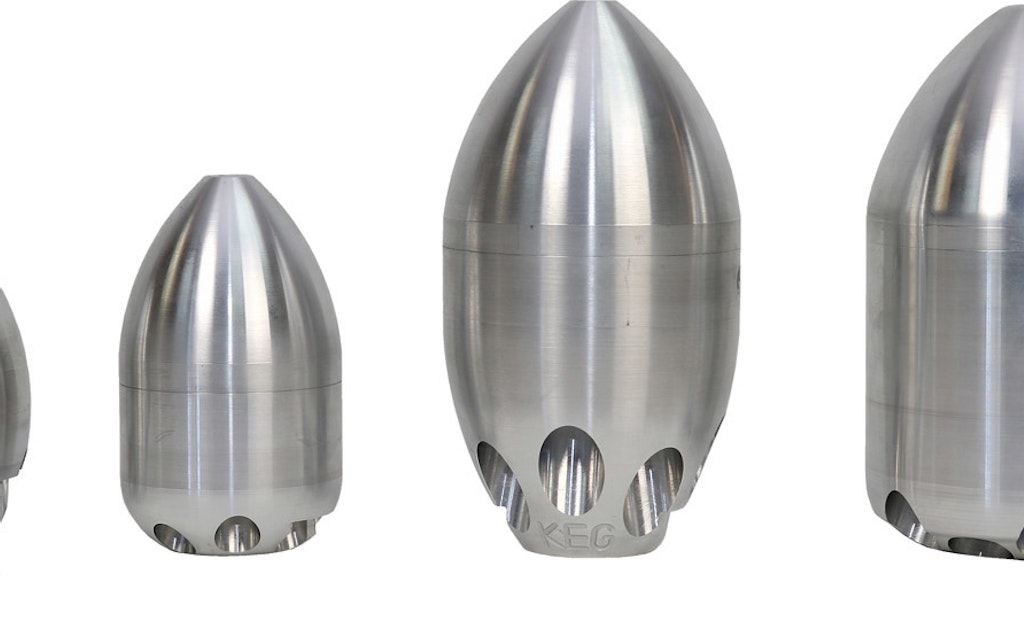Interested in Cleaning?
Get Cleaning articles, news and videos right in your inbox! Sign up now.
Cleaning + Get AlertsIn municipal sewer, storm and sanitary line cleaning, hose nozzles are essential tools that direct pressurized water to clear obstructions and clean lines as part of regular maintenance or to prepare pipes for relining. In this way, the nozzle is like a gun and water like bullets that must be precisely directed with force to the target.
While there are many nozzle options available in a variety of configurations, the standard Tier 2 nozzles that are typically supplied with the purchase of a sewer truck are only rated 50-60% efficient. Although these nozzles can handle some blockages, opting for higher-efficiency nozzles can make short work of even the most challenging jobs.
Utilizing high-performance nozzles has benefits that go far beyond conserving water to protect the environment. Reducing water use also minimizes trips to refill the sewer truck water tank and keeps crews effectively cleaning to expedite work completion. By decreasing unnecessary travel, the approach also reduces the cost of vehicle fuel and maintenance, which further stretches municipal budgets.
Getting efficient
As is known throughout the industry, there are tiers of nozzles, rated for water efficiency from Tier 1 (about 30% efficient), Tier 2 (50-60% efficient), to Tier 3 (75-98% efficient). Although they cost less, low-efficiency Tier 1 nozzles tend to utilize only 30% of the available energy, wasting 70% due to excessive turbulence and often lacking the necessary precision to clear obstructions. Tier 2 nozzles are more efficient, but are still not adequate to tackle tougher jobs or perform with anywhere near the efficiency offered by more sophisticated units.
In contrast, the most effective Tier 3 nozzles have tight water patterns that efficiently clean the pipe wall and create a powerful water stream to move debris long distances and propel the nozzle. Crucially, these nozzles provide efficient fluid mechanics to prevent the wasteful use of water and operating pressure.
However, even within the Tier 3 category there are significant differences in levels of efficiency. Opting for the lower-end Tier 3 nozzle with 75% efficiency could still lead to additional trips to refill. Additionally, such units may take longer to remove restrictive sewer buildups or blockages.
To proactively improve operations, municipal supervisors responsible for sewer, storm and sanitary line cleaning are turning to the most efficient Tier 3 nozzles. This is enabling sewer maintenance crews to clean better and faster while conserving water and accomplish dramatically more between each water tank refill. This approach also substantially reduces labor and machine hours to clean lines, along with equipment wear and tear, and can save up to 17% in vehicle fuel costs, including travel to refill water tanks and run equipment.
Race car engineering
Fayetteville, North Carolina’s Public Works Commission maintains over 1,300 miles of sewer mains, 79 miles of forced sewer mains and 85 lift stations. As a regional utility provider, PWC also maintains and operates several sanitary sewer systems in the area.
According to Marty Tew, a Fayetteville PWC Water Resources construction field supervisor, the municipality’s management and technicians’ eyes were first opened to the effectiveness of high-efficiency Tier 3 nozzles during a hands-on sewer cleaning demonstration at an on-site training session.
“In the demo, when our trainer walked down one of our 60-year-old sewers, cleaning with a KEG Tier 3 nozzle, the waste stream went black. When he returned cleaning, the waste stream was clear and the pipe looked brand-new inside. That was the proof in the pudding for me and our operators,” Tew says.
Not long after the training and demonstration, the municipality updated its sewer truck nozzles with mostly Tier 3 nozzles from KEG.
According to Tew, refilling the sewer truck tank with water can take 30 minutes to an hour, depending on the hydrant location, so the municipality also values the efficiency gained with Tier 3 nozzles.
“When virtually up to double the amount of sewer pipe can be cleaned with a 98% water-efficient Tier 3 nozzle, compared to a 50% water-efficient Tier 2 nozzle, that minimizes crew cleaning downtime that results from making frequent trips to refill the vehicle’s water tank,” Tew says.
He adds that having to make fewer water tank refills is an even greater boost to productivity when crews in multiple vehicles are involved with sewer cleaning and may be dependent on having a steady water supply to continue their work.
Tew notes that more efficient water use also reduces vehicle fuel use as well as wear and tear by requiring fewer trips to the hydrant.
By conserving water and reducing the necessity of refilling water tanks at hydrants, the nozzles also minimize the need for municipal vehicles to travel through environmentally sensitive areas like wetlands, and difficult to traverse areas such as back roads.
What sets the most efficient Tier 3 nozzles apart from others in the category is fluid mechanics engineering on par with the aero-dynamics of race cars or fighter jets.
An essential tool
In the case of KEG’s Tier 3 nozzles, the high-performance fluid mechanics design leaves little room for power loss or excessive turbulence. After exiting the jetter hose, water travels into the body of the nozzle before moving through smooth, curved channels. This design enables the water to maintain its power and speed before entering the nozzle’s replaceable titanium ceramic inserts. Next, the water is funneled from a short conical shape to a larger, longer cylindrical shape, allowing a tight water pattern to emerge.
The internal workings of the nozzle, including the way the water gets turned, redirects the energy of the high-pressure water entering the nozzle as efficiently as possible. This results in what is needed for the task: more thrust and power using less water.
“On tough cleaning jobs like restaurant rows with heavy grease buildup, the Tier 3 nozzles are particularly helpful. Where a Tier 2 nozzle might take multiple passes to provide an adequate clean, a top Tier 3 nozzle can do a better job with far fewer passes,” Tew says.
He estimates that by switching to ultra-efficient Tier 3 nozzles, Fayetteville’s municipal PWC got about a one-year return on its investment in terms of more efficient labor and resource use, including decreased fuel use and avoiding potential vehicle and crew downtime.
While Tew does not insist that such a Tier 3 nozzle is necessary for every job, he does recommend it as an essential tool for the municipal sewer crew’s toolbox.
In addition, he points out that the increased efficiency of municipal work crews equipped with Tier 3 nozzles has made meeting North Carolina state mandates for sewer maintenance easier.
“We are mandated by the state to clean 10% of our sewers a year,” he says. “While we have always met that target, we are actually above the goal now and our cleaning is far more efficient than it ever has been.
“The Tier 3 nozzles, along with superior cleaning methods, are helping us to better maintain public sewer systems and keep costs down for ratepayers.”









